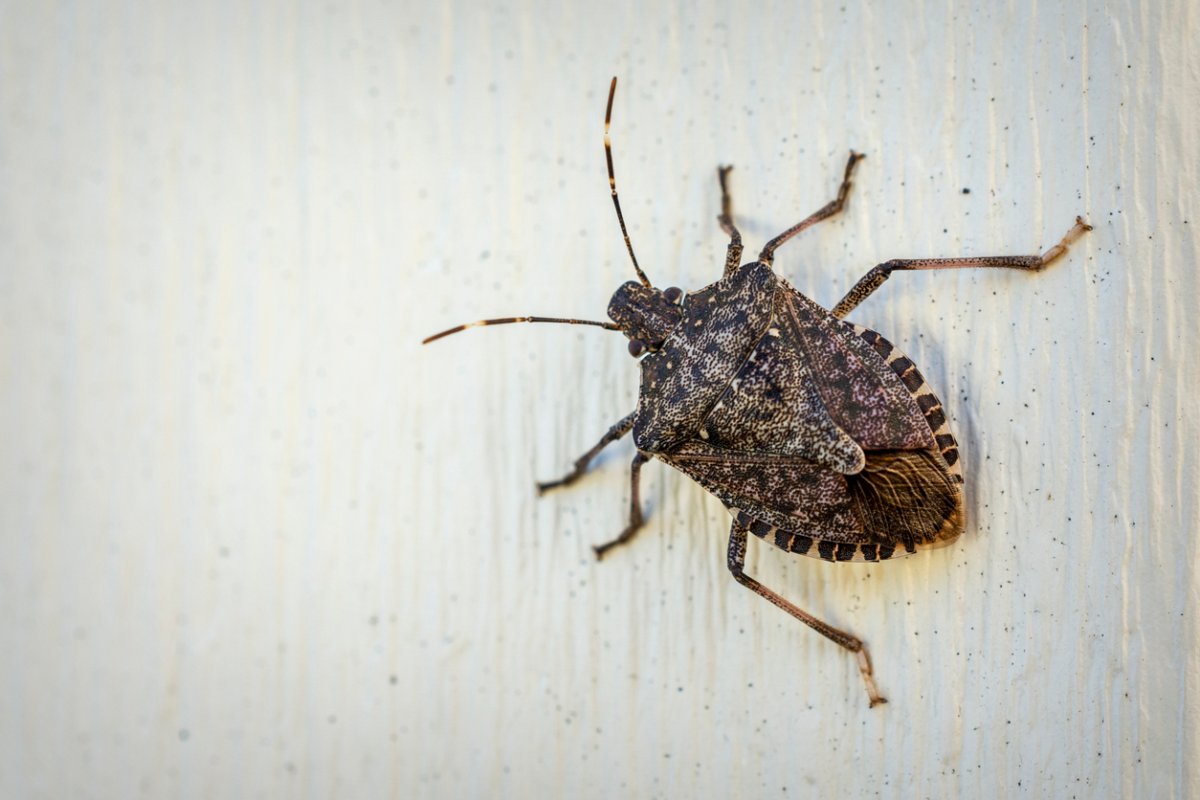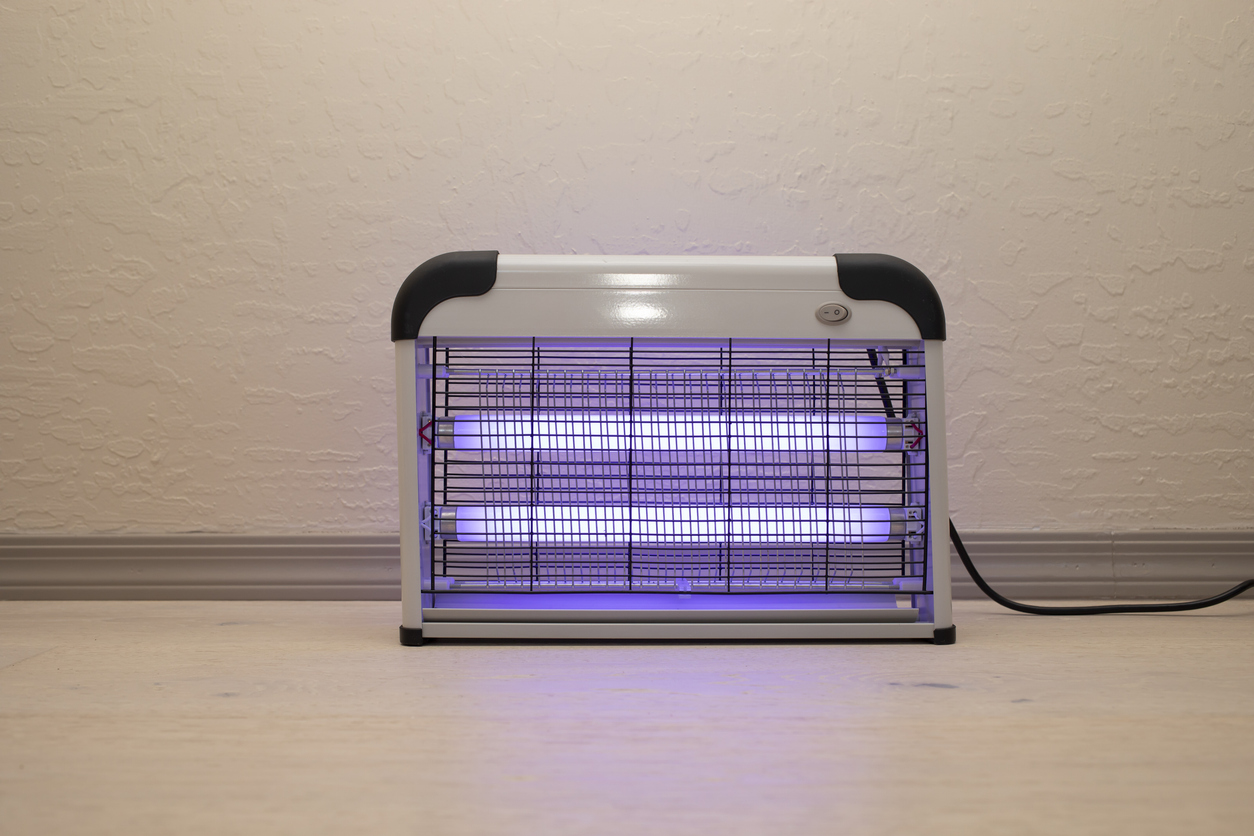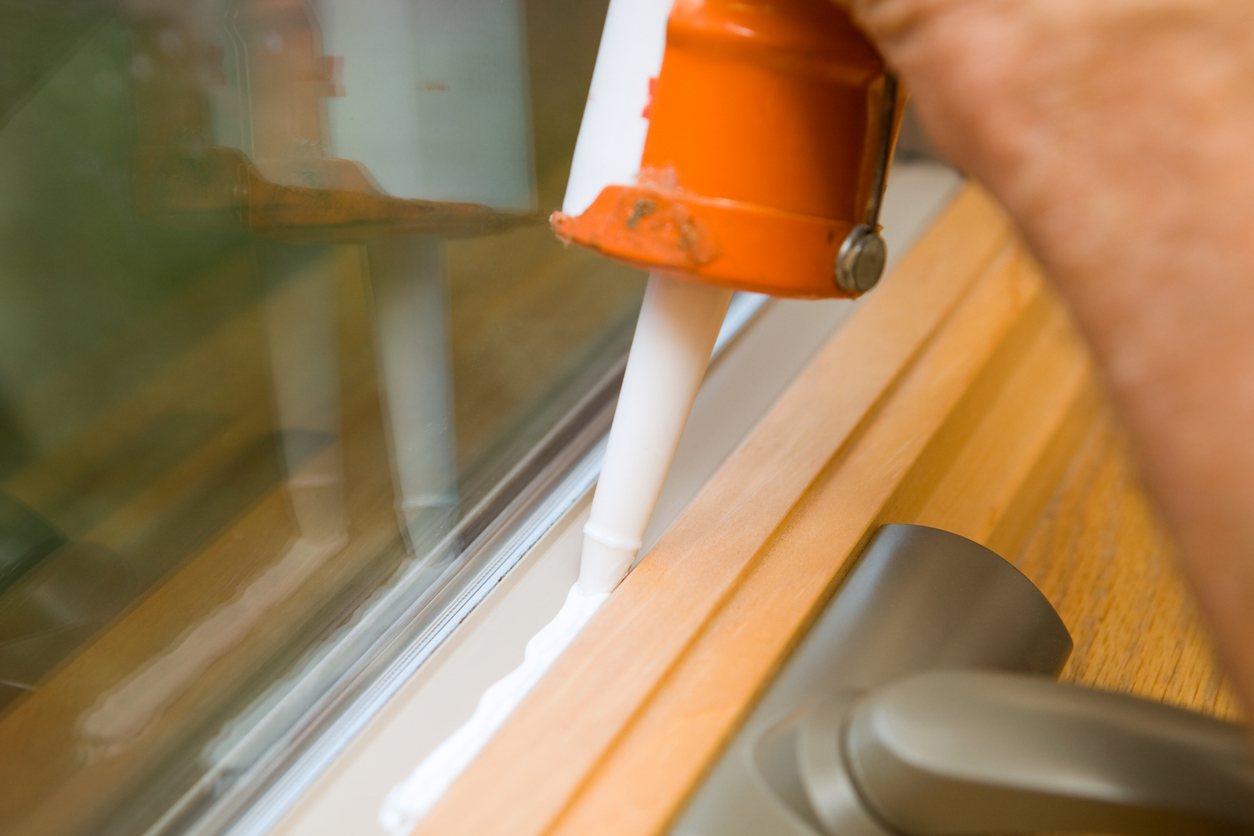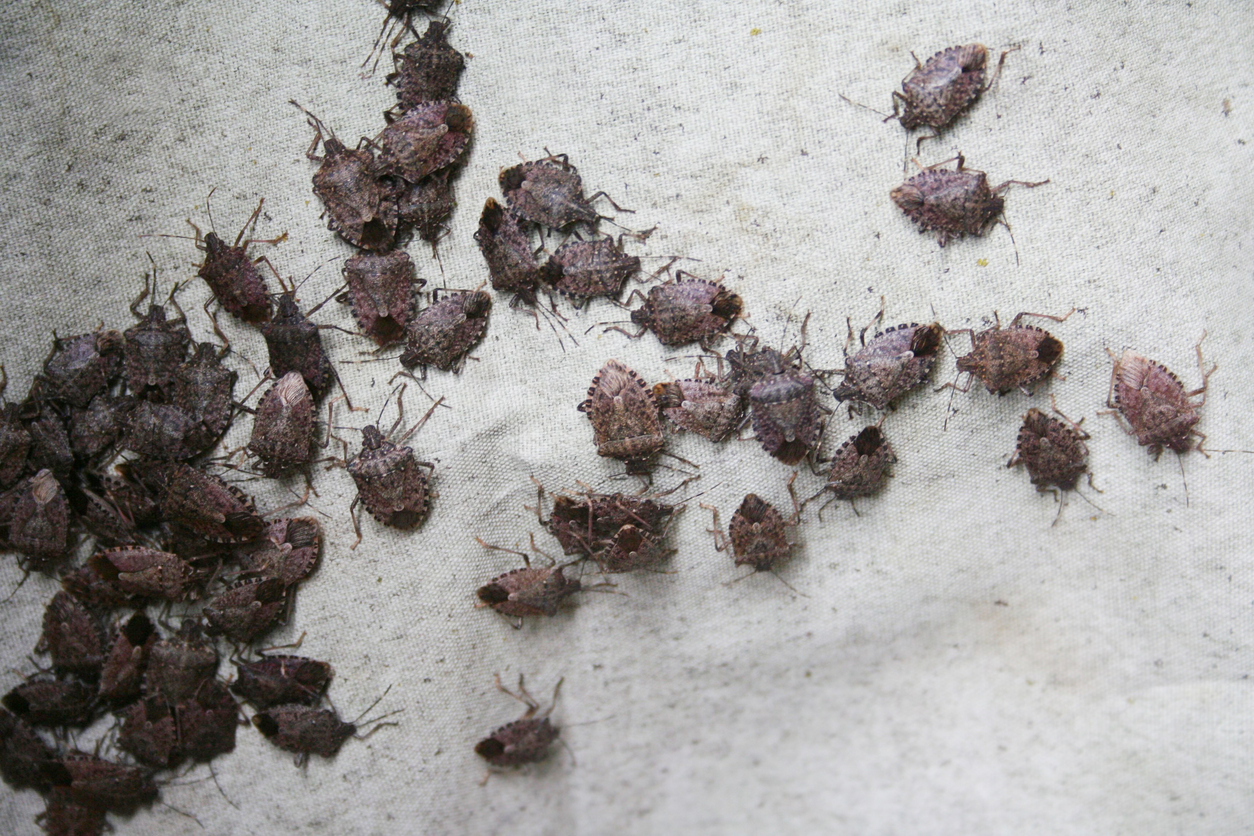

We may earn revenue from the products available on this page and participate in affiliate programs. Learn More ›
The brown marmorated stink bug is a stowaway from Asia that entered the U.S. sometime in the 1990s. Adult stink bugs are approximately the size of a dime and easily recognized by their shield shape, mottled gray-brown coloring, and alternating light and dark bands on their antennae and abdomen. They can also, of course, be identified by the unpleasant odor they release, often described as a strong cilantro-like smell, when they are threatened or squashed. (Not everyone is sensitive to the smell, so it’s possible to have an infestation even if you don’t perceive the odor.)
As of 2021, the brown marmorated stink bug had been found in 47 states, and it’s earned a rep as an agricultural villain, feeding on upward of 60 different species of fruits, vegetables, and ornamental plants. But its habits have also made it a notable household nuisance.
What attracts stink bugs?
Outdoors, stink bugs are attracted to a wide range of plants. But when the weather turns cold and they start searching for a place to spend the winter, they, like so many other bugs, seek the warmth and shelter of your home. In these colder months, they enter a dormant phase during which they’re inactive, neither feeding nor reproducing. In fact, they’re model insect houseguests: They don’t move around much, damage structures or clothing, reproduce, or bite people or animals. Stink bugs are not poisonous, and they won’t raid the pantry.
Stink bugs do, however, have some big drawbacks, including their noxious odor. Unfortunately, they also release a pheromone that attracts other stink bugs, which means they can gather in numbers reaching into the hundreds or even thousands.
While dormant, stink bugs may move around slowly, if at all. You are most likely to notice them in the fall, when they’re coming indoors, or in early spring as they head back outside to mate. David Price, associate certified entomologist and director of technical services at Mosquito Joe, a Neighborly company, “They do not leave behind any visible indications they have chosen your home, other than their physical appearance.” This means that you might not know you have a stink bug infestation until you actually see a bug, dead or alive.
How to Get Rid of Stink Bugs in the House

Commercial insecticides may kill off some of the stink bugs in your house, but these toxic methods are generally ineffective and don’t offer a long-term solution. “Their shield provides them with protection against many insecticides,” Price says. Even after treatment, bugs can migrate from other areas of the house or emerge from cracks and crevices, including gaps around baseboards and molding. Insecticides do nothing to prevent more bugs from coming in, either. If you’re trying to figure out how to eliminate stink bugs, the most effective approaches are physical removal and deterrence.
For physical removal, focus on areas where stink bugs tend to congregate. Price notes that they typically gather in the “attic, or voids around windows,” and they’re attracted to light-colored surfaces and the sunny side of a house. Stink bugs are also known to tuck themselves into folds of curtains, hole up in crevices, and seek out quiet spots like crawl spaces.
1. Vacuum or sweep up stink bugs.
You can use either a regular vacuum or a wet/dry vacuum, but use just the hose. Steer clear of attachments that might crush the bugs. You will need to clean out the vacuum when done. While the smell will eventually wear off, if your home is subject to frequent infestations, you may want to invest in a dedicated vacuum or handheld vac. Another option: Slip a knee-high stocking over the vacuum hose, secure it with a rubber band, and stuff the toe of the stocking down the hose so the stink bugs will be captured in the stocking instead of the vacuum canister.
- Wet vac: First, put some water in the bottom of the canister and mix in a few teaspoons of dish soap. The soapy water should kill the bugs that get sucked in. Dispose of the bugs in a plastic bag, close it tightly, and place it in a trash can well away from the house.
- Dry vac: Avoid using a bagless model. To dispose of the bugs, put the full vacuum bag (or stocking) into a plastic bag, tie it up, and place it in a trash can outside. You can also dump the contents of the bag into a bucket of soapy water before throwing the bugs away.
If you are sweeping up stink bugs with a broom, it’s a good idea to sweep or dump them directly into a bucket of soapy water. Dispose of the bugs outside the house in a tied plastic bag.
2. Spray them with soapy water.
A direct hit with a stream of soapy water from a spray bottle should kill a stink bug. It takes just a few teaspoons of dish soap in a spray bottle filled with water.
3. Build a stink bug trap.
Trapping stink bugs when they’re on the move is an inexpensive but effective strategy, especially in the spring, when the brighter, longer days signal that it’s time for them to head outside and mate.
- Fill a foil roasting pan with water.
- Stir in a few squirts of dish soap.
- Position a desk lamp near the pan, turn it on, and shine the light on the water.
- Leave the trap in a dark room overnight.
- Collect the dead stink bugs in a plastic bag and throw it away.
4. Immobilize the bugs with hair spray.
A spritz of hair spray can paralyze a stink bug so you can either drop it in a bucket of soapy water or simply take it outside. Take care using this method near upholstery, leather, and other surfaces that could be damaged by hair spray.
5. Try a bug zapper.
Stink bugs are attracted to light, including the blue UV light that bug zappers use. While not the most effective method, a good bug zapper can be a useful ally. Note that entomologists and others concerned with the environment discourage the use of zappers, which kill good and bad bugs alike.
How to Keep Stink Bugs Away

Even if you’ve successfully eliminated stink bugs from your home, you’ll continue to have problems if you can’t prevent more bugs from coming in. The key to keeping stink bugs out is to seal up common entry points.
1. Caulk around windows and doors.
Fill cracks around windows and doors, both indoors and out, with exterior caulk.
2. Seal gaps around utility entry points.
Check around plumbing pipes, AC lines, cables, electrical conduits, and other pipes that pass through the exterior walls of your home. Seal up gaps, indoors and out, with plumber’s putty, sealant, spray foam, or another appropriate filler.
3. Keep siding in good repair.
Periodically, and certainly before fall kicks in, check your home’s siding for gaps and holes. Caulk gaps as needed.
4. Seal off crawl spaces.
Make sure there are no openings to the outside (check for daylight showing through). Also, look for cracks in the walls.
5. Remove window air conditioners.
When possible, remove window air conditioners at summer’s end. If they must stay in all year, seal up any gaps around the unit and cover it before the weather turns colder.
6. Weatherstrip doors.
Check weatherstripping around doors for wear and tear, such as missing pieces and other damage. Replace weatherstripping as necessary.
7. Check screens for holes.
Look for rips and tears in window or door screens, and repair or replace damaged screens promptly. Invest in screens if some of your windows or doors don’t have them.
8. Install screens on vents.
Screen gable vents, eave vents, and other openings to prevent stink bugs from gaining access.
9. Deter them with essential oils.
All of the sealing methods rank high in advice for how to deter stink bugs from invading your house. A bonus method is use of various essential oils, especially clove, lemongrass, spearmint, and ylang-ylang, which can discourage stink bugs from coming in. Combine about 10 or so drops of the essential oil of your choice (or a combination of a few oils) with water in a spray bottle, and spray windowsills, window frames, doorways, and other common entry points regularly in fall. Another option is to mix a few teaspoons of garlic powder with a few cups of water and spray the solution around entry points.
When to Call an Exterminator

These removal and deterrence strategies can help control a modest infestation, but if you’ve tried all of these and your home is still overwhelmed by hundreds of stink bugs, you need a pro. Pest control companies can employ multiple techniques to stop an infestation, including vacuuming, applying specialized dusts and powders, and sealing off or treating entry points. They also can provide advice on preventing future infestations.
FAQs
Keeping a home properly sealed prevents stink bugs from entering. It’s important to check the perimeter and openings annually, and seal or weatherstrip as needed.
Rake up debris and edible vegetation around your home’s foundation, keep wood piles and compost heaps well away from the house, and consider turning off interior and exterior lights near entrances when possible.
Although this is a common belief, killing a stink bug does not attract others.
Yes, you can flush stink bugs down the toilet. Flushing is a good way to get rid of them without giving them a chance to release their scent.
Vacuuming is the fastest and most efficient way to remove stink bugs. For easy disposal, use a vacuum with a bag.
